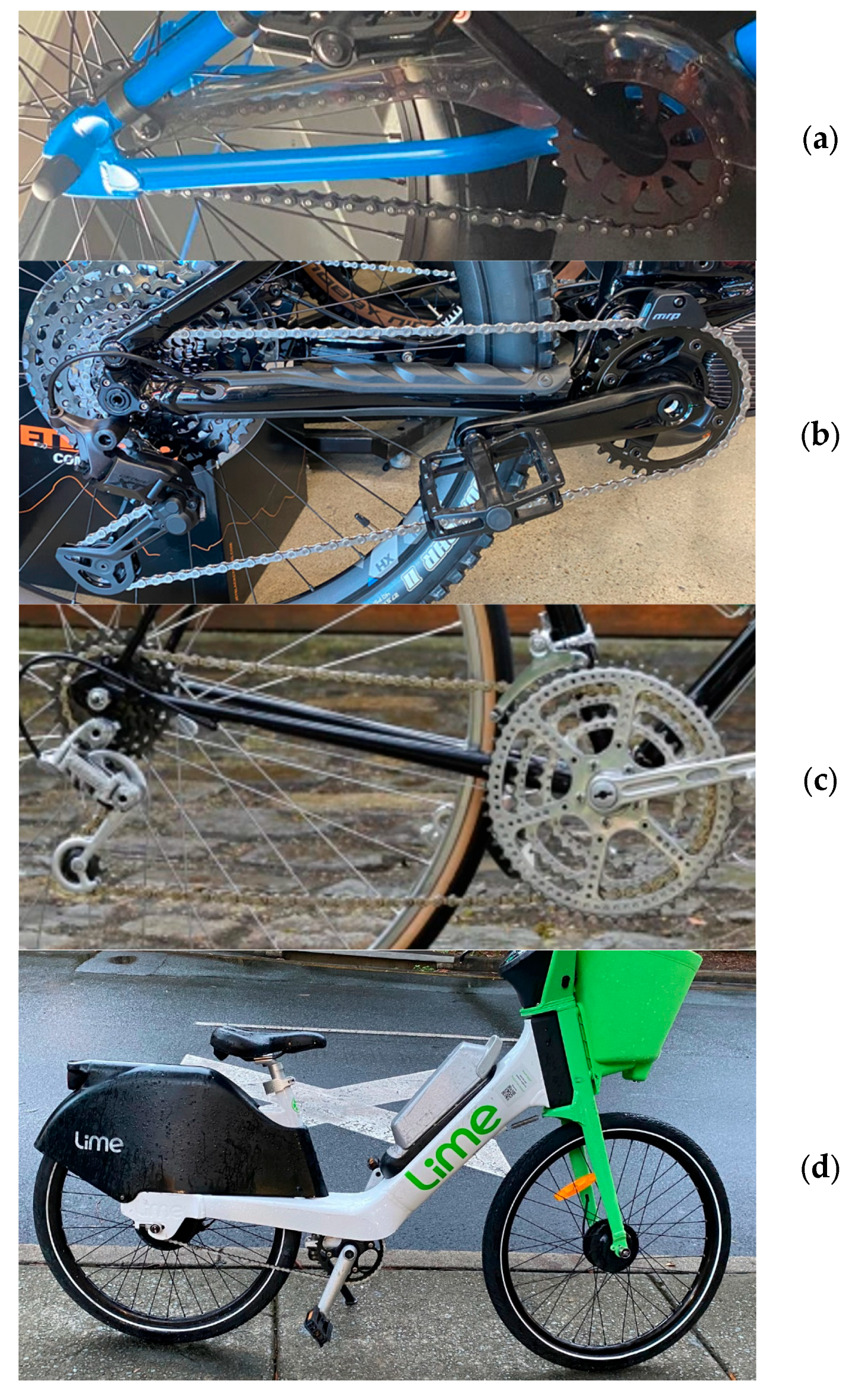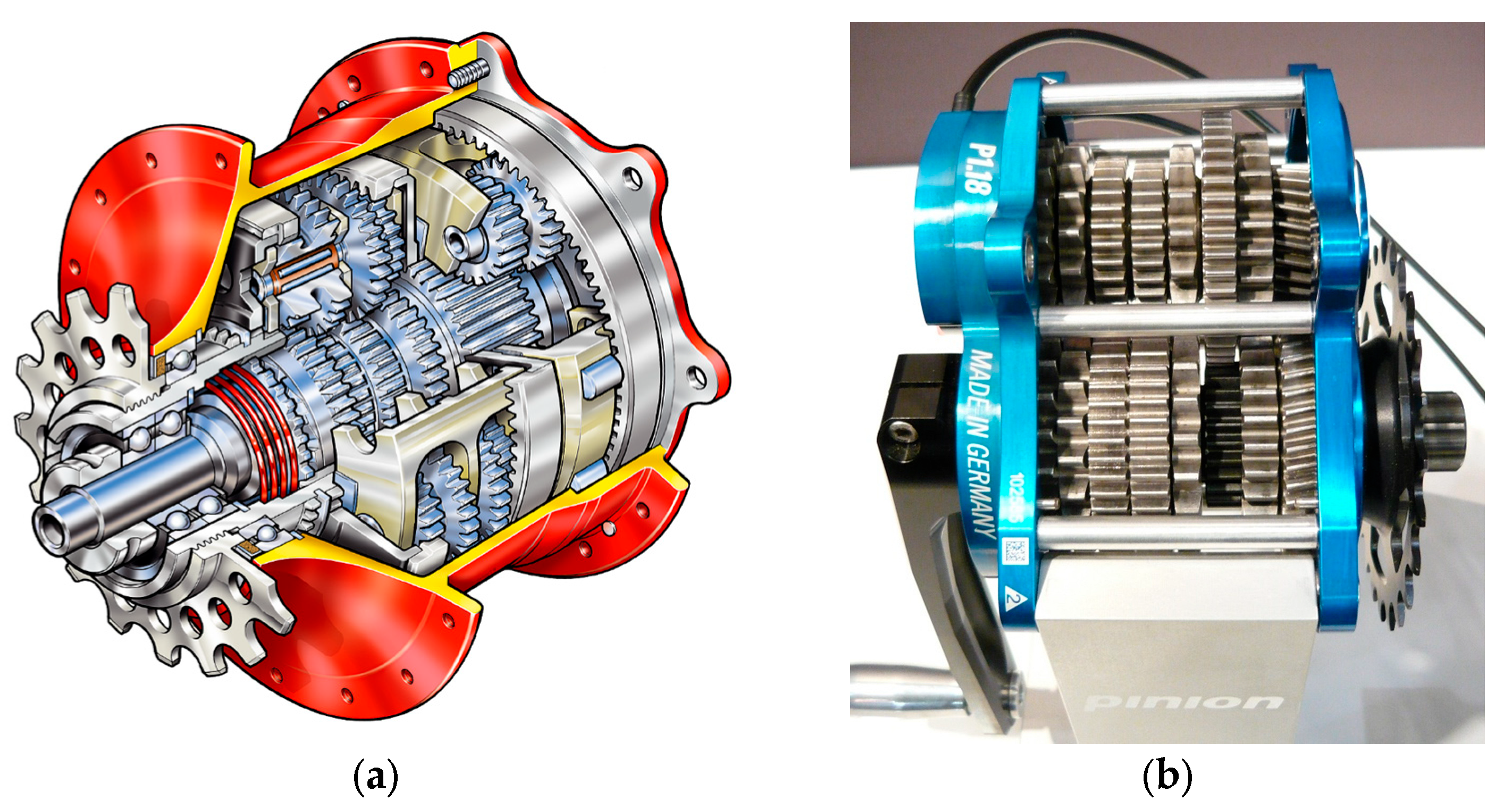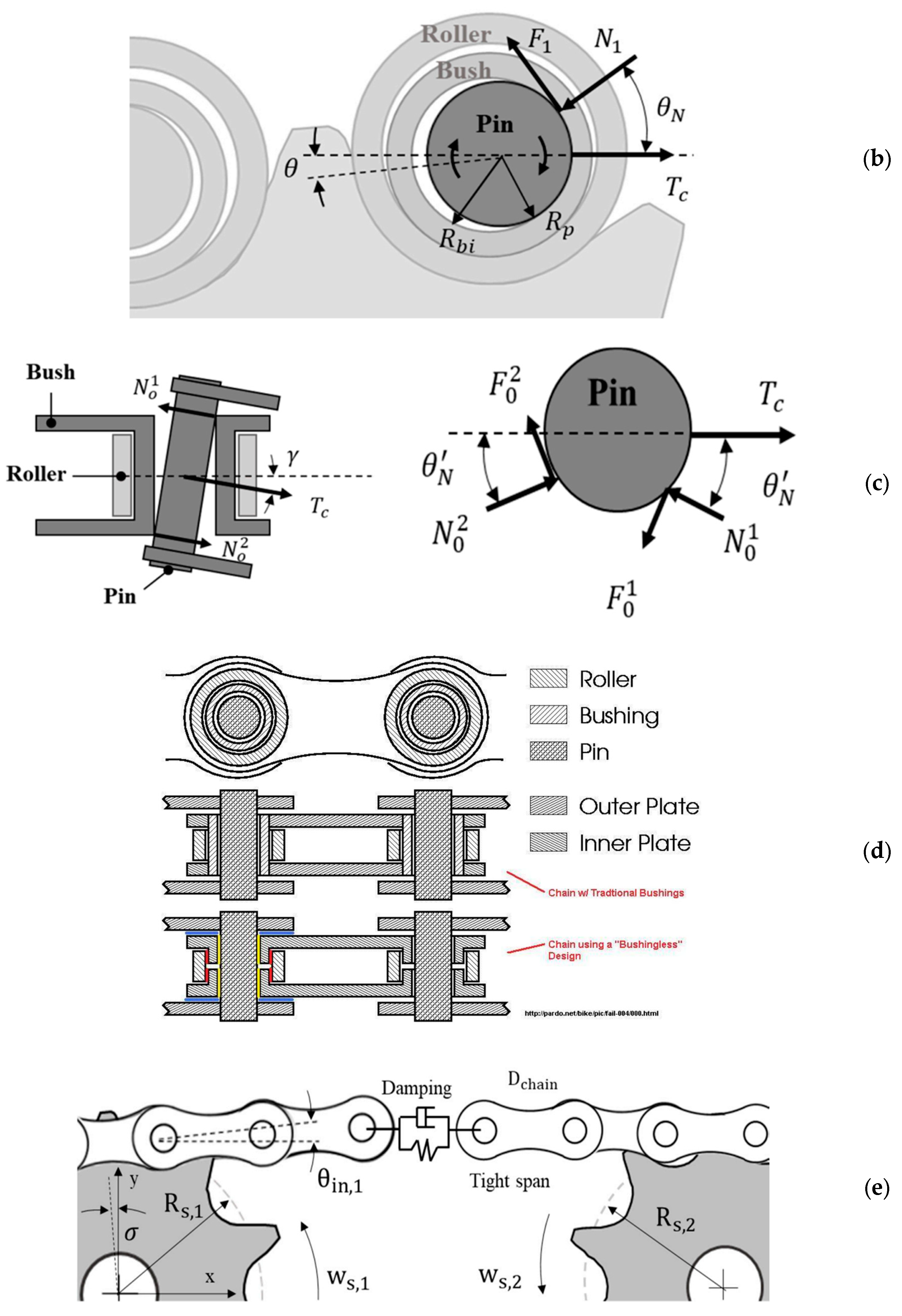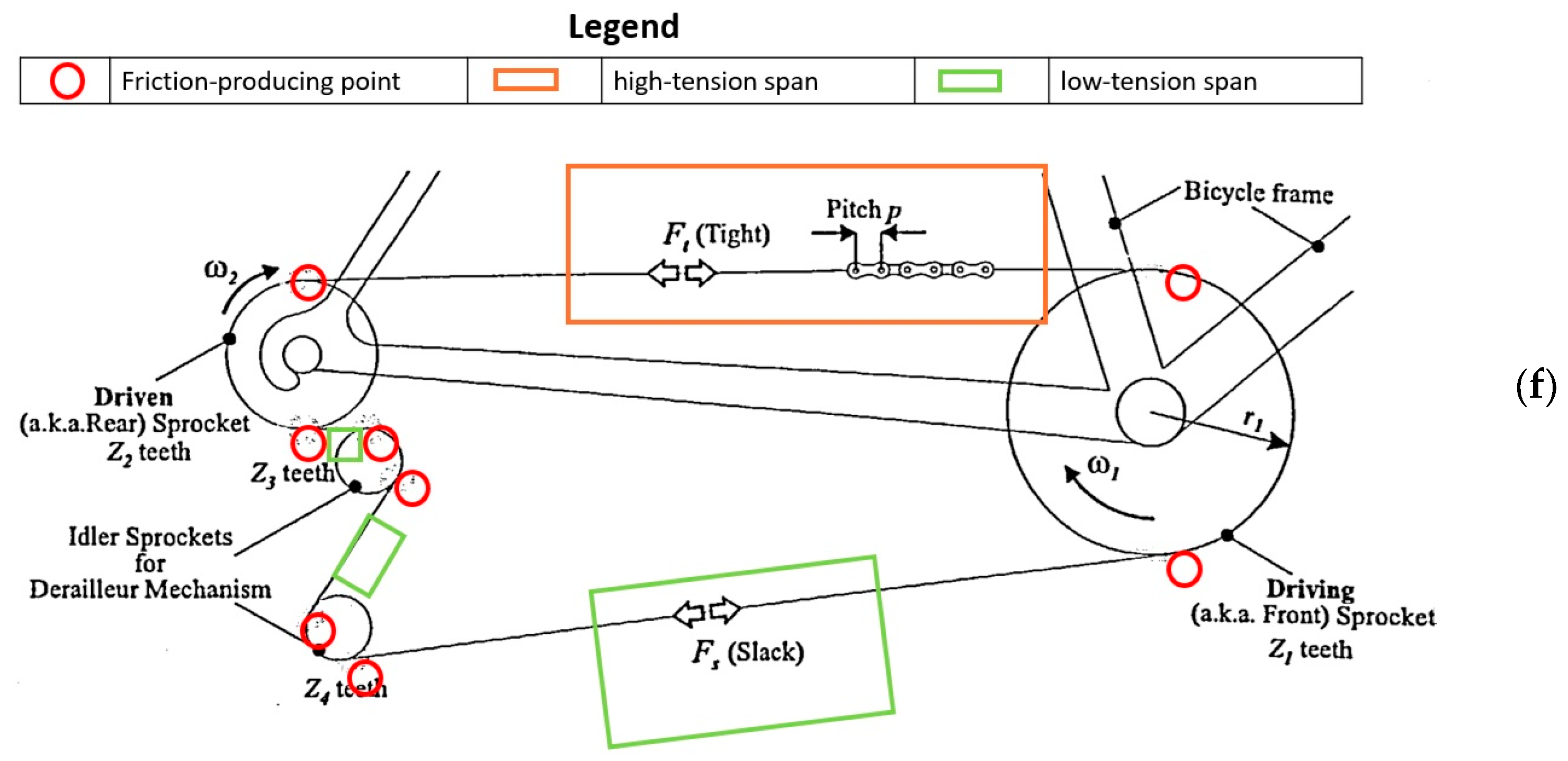Power Transmission Mechanism and Tribological Performance of Modern Bicycle Drivetrains—A Review
Abstract
1. Introduction
2. Mechanisms and Components in Bicycle Drivetrains

2.1. Roller Chain Drives
2.1.1. Cranksets and Sprockets
2.1.2. Chains
2.1.3. Chain Drive Configuration
2.2. Gear-Shifting Mechanisms
2.2.1. Derailleurs
2.2.2. Gear Hubs and Gearboxes
2.3. Belt Drive Transmission
2.4. Drivetrain with Power-Assisted Module for E-Bikes
3. Power Transmission Mechanics and Efficiency
3.1. Mechanics of Power Loss and Factors Affecting Efficiency
3.2. Contact Mechanics Between the Chain and Sprockets
3.3. Analysis of Forces
3.4. Kinematic and Dynamic Behaviour in Bicycle Drivetrains
4. Tribological Performance in Bicycle Drivetrains
4.1. Wear
4.1.1. Mechanics of Wear in Chain Drives
4.1.2. Detection of Chain Drive Wear
4.2. Lubrication
4.2.1. Types of Chain Drive Lubrication
4.2.2. Effects of Chain Drive Lubrication
- Dry lubricant, such as paraffin wax, offers superior performance in terms of efficiency, longevity, and resistance to water and dirt. However, the application method is fully immersive and time-consuming.
- Liquid lubricants with additives such as PTFE or wax generally exhibit better performance.
- Renewable lubricants derived from bio-derived oils can achieve good friction reduction but may lack resistance to oxidation and heat.
- Wax and grease have a longer lasting time than liquid products but are difficult to clean afterwards.
- Wet lubricants and weather conditions can attract contaminants, leading to increased friction in the chain. Thus, resetting the lubrication is recommended if cycling off-road.
- High temperatures can reduce oil viscosity, resulting in a smaller lubrication film interacting with contact surface asperities. Clean oil can improve performance, but the presence of dust, debris, or particles can introduce additional friction to the system.
- The lubrication method significantly impacts efficiency. Frequent lubrication to the drivetrain during cycling, such as drip or spray application, is recommended. While immersive soaking offers better results, it is impractical for typical cycling conditions.
5. Conclusions and Future Perspectives
- Modern bicycle drivetrains have widely utilised bushingless chains and the wide–narrow teeth chainrings, which deviate from the conventional design of roller chain drive systems. However, there is very little research that specifically delves into these types of chain drives. Investigating the performance and characteristics of bushingless chains can provide valuable insights into their physical properties, efficiencies, and tribological behaviours. Achievements on understanding the friction force, wear resistance, dynamic characteristics, and development of corresponding simulation models can facilitate industry to improve products.
- There is a critical need for research and innovations in friction reduction within the drivetrain to enhance tribological performance. This can be achieved through innovative lubrication techniques, surface treatments, and exploring the potential of novel materials and coatings to minimise wear and increase efficiency. The integration of advanced materials, such as light alloys and ceramics, can also play a pivotal role in developing more durable and lightweight drivetrain components.
- The trend in modelling and simulation for bicycle drivetrain research involves a more profound understanding of the power transmission mechanisms and an increasing reliance on advanced computational tools. It allows for a detailed analysis and optimisation of various aspects of the drivetrain system. Accurate characterisation of the empirical parameters, including friction coefficients, is crucial. Further research is needed to explore the impact of key components in the chain drive, such as pin, bushing, and roller dimensions, on power loss and wear rates. This investigation will aid in designing more efficient and durable chain drives.
- The electric bicycle industry has experienced significant development in recent years. The adoption of electronic drivetrains, including electronic shifting systems and advanced motor controllers, is on the rise. Innovations such as internal gear hubs, belt drives, and automatic transmission are gaining popularity. There is a need to make them lightweight, more reliable, and affordable. This evolving landscape presents new challenges and opportunities that warrant special attention in drivetrain research.
Author Contributions
Funding
Acknowledgments
Conflicts of Interest
References
- Tabascio, A.; Tiznado-Aitken, I.; Harris, D.; Farber, S. Assessing the potential of cycling growth in Toronto, Canada. Int. J. Sustain. Transp. 2023, 17, 1370–1383. [Google Scholar] [CrossRef]
- Oliveira, F.; Nery, D.; Costa, D.G.; Silva, I. A Survey of Technologies and Recent Developments for Sustainable Smart Cycling. Sustainability 2021, 13, 3422. [Google Scholar] [CrossRef]
- Chen, W.; Carstensen, T.A.; Wang, R.; Derrible, S.; Rueda, D.R.; Nieuwenhuijsen, M.J.; Liu, G. Historical patterns and sustainability implications of worldwide bicycle ownership and use. Commun. Earth Environ. 2022, 3, 171. [Google Scholar] [CrossRef]
- Thomas, F. 2022 World Bicycle Industry Report: An Industry Addicted to N + 1. a-dbikes.com. 2024. Available online: https://a-dbikes.com/blogs/news/analysis-of-world-bicycle-industry-association-report-2022?srsltid=AfmBOopdwK0F6VwbsJTcTIYJlrFfi_YKhHirQEaOZtCtEgQ8H9DYyouc&utm_source=chatgpt.com (accessed on 14 January 2025).
- Grand View Research. Bicycle Market Analysis Report. 2023. Available online: https://www.grandviewresearch.com/industry-analysis/bicycle-market#:~:text=ReportOverview,anticipatedtopropelmarketgrowth (accessed on 1 February 2023).
- Wilson, D.G.; Schmidt, T. Bicycling Science, 4th ed.; Massachusetts Institute of Technology: Cambridge, MA, USA, 2020. [Google Scholar]
- Rérat, P. The rise of the e-bike: Towards an extension of the practice of cycling? Mobilities 2021, 16, 423–439. [Google Scholar] [CrossRef]
- Teixeira, J.F.; Silva, C.; Moura, F. Empirical evidence on the impacts of bikesharing: A literature review. Transp. Rev. 2021, 41, 329–351. [Google Scholar] [CrossRef]
- Popan, C. Introduction Tips of the cycling iceberg. In Bicycle Utopias: Imagining Fast and Slow Cycling Futures; Taylor & Francis Group: Abingdon, UK, 2018. [Google Scholar] [CrossRef]
- Malizia, F.; Blocken, B. Cyclist aerodynamics through time: Better, faster, stronger. J. Wind. Eng. Ind. Aerodyn. 2021, 214, 104673. [Google Scholar] [CrossRef]
- Holmberg, K.; Erdemir, A. Influence of tribology on global energy consumption, costs and emissions. Friction 2017, 5, 263–284. [Google Scholar] [CrossRef]
- Underwood, L.; Jermy, M. Determining optimal pacing strategy for the track cycling individual pursuit event with a fixed energy mathematical model. Sports Eng. 2014, 17, 183–196. [Google Scholar] [CrossRef]
- Pickering, C.; Byrne, J. The benefits of publishing systematic quantitative literature reviews for PhD candidates and other early-career researchers. High. Educ. Res. Dev. 2014, 33, 534–548. [Google Scholar] [CrossRef]
- Lovejoy, K.; Handy, S. Developments in bicycle equipment and its role in promoting cycling as a travel mode. In City Cycling; MIT Press: Cambridge, MA, USA, 2012; pp. 75–104. [Google Scholar]
- Stead Cycles. Single Speed vs Geared Bikes. 2023. Available online: https://www.steadcycles.com.au/singlespeed-vs-gearedbikes/ (accessed on 23 March 2023).
- Thakur, T.S.; Babu, P.M. Evolution of Bicycles and their utility as Fitness aids—A Review. IOSR J. Nurs. Health Sci. 2019, 8, 19–23. [Google Scholar]
- Dawson, T. H.R.Morris 1968, with Beautifully Carved Lugwork. Vintage Bicycle Blog. 2020. Available online: https://vintagebicycle.wordpress.com/page/2/ (accessed on 5 March 2024).
- Malppan, G.J.; Sunny, T. A Review on Design Developments in Bicycle. Int. Res. J. Eng. Technol. 2015, 2, 1794–1799. Available online: https://www.researchgate.net/profile/Tom-Sunny-2/publication/280698135_A_Review_on_Design_Developments_in_Bicycle/links/602ef0a292851c4ed5804753/A-Review-on-Design-Developments-in-Bicycle.pdf (accessed on 28 October 2024).
- Urunkar, R.U.; Deshpande, P.P. Study of Drive Mechanisms of Bicycle, Tricycle or Like Vehicles to Optimize Operating Performance-A Review. J. Eng. Res. Appl. 2014, 4, 214–219. Available online: https://www.ijera.com/papers/Vol4_issue1/Version%202/AC4102214219.pdf (accessed on 28 October 2024).
- Stratview Research. Belts, Chains and Gears: How Power Transmission Works. EETech Media. 2022. Available online: https://eepower.com/technical-articles/belts-chains-and-gears-how-power-transmission-works/# (accessed on 24 March 2023).
- SRAM. Spare Parts Catalog; SRAM: Chicago, IL, USA, 2023. [Google Scholar] [CrossRef]
- Reiter, M.; Florczyk, R.; Braedt, H. Chainring. U.S. Patent US 11,110,991 B2, 7 September 2021. Available online: https://patents.justia.com/patent/11110991 (accessed on 10 January 2025).
- Livesey, A. Bicycle Engineering and Technology; Routledge, Taylor & Francis Group: Abingdon, UK, 2021. [Google Scholar]
- Berto, F.J. The Sunset of Suntour. In Proceedings of the 9th International Cycling History Conference, Ottawa, ON, Canada, 19–21 August 1998; Volume 9, pp. 116–140. Available online: https://www.mechanischehirngespinnste.de/wp-content/uploads/2021/07/sunset_of_suntour.pdf (accessed on 28 October 2024).
- Wagner, M.; Koch, T.; Kuehne, I.; Frey, A. Analysis of Static Stress in a Bicycle Chain Plate. In Proceedings of the 2015 COMSOL Conference, Grenoble, France, 14–16 October 2015; pp. 1–6. [Google Scholar]
- Dupoyet, G.J.M. The Transmission Chain. Published Online 1981. Available online: https://ridemechanic.com.au/wp-content/uploads/2019/08/Sedis_US4265134A.pdf (accessed on 28 October 2024).
- Cho, C.K.; Yun, M.H.; Yoon, C.S.; Lee, M.W. An ergonomic study on the optimal gear ratio for a multi-speed bicycle. Int. J. Ind. Ergon. 1999, 23, 95–100. [Google Scholar] [CrossRef]
- Van Soest, A.J. From bicycle chain ring shape to gear ratio : Algorithm and examples. J. Biomech. 2014, 47, 281–283. [Google Scholar] [CrossRef] [PubMed]
- Mo, Y.; Xu, X. Solidworks chain drive design and 3D modeling techniques. Appl. Mech. Mater. 2012, 215–216, 1146–1149. [Google Scholar] [CrossRef]
- Wang, L. Simulation of chain drive based on MSC. Visual nastran 4D. Appl. Mech. Mater. 2012, 101–102, 267–270. [Google Scholar] [CrossRef]
- Suciu, P. When Were Bicycle Gears Invented? Bikeradar. 2012. Available online: https://www.bikeradar.com/features/when-were-bicycle-gears-invented/#:~:text=In1895FrenchmanJeanLoubeyre,thePolyceler(multispeed).&text=Thederailleurwasdevelopedin,allowedgearingtobeused (accessed on 4 May 2023).
- Lin, T.Y.; Tseng, C.H.; Fong, Z.H. An experimental approach characterizing rear bicycle derailleur systems Part II: The stability region and its applications. Int. J. Veh. Des. 1998, 19, 371–384. [Google Scholar]
- Hadland, T.; Lessing, H. Bicycle Design: An Illustrated History; The MIT Press: Cambridge, MA, USA, 2014. [Google Scholar]
- Wikipedia Contributors. Gearbox Bicycle. Wikipedia, The Free Encyclopedia. 2024. Available online: https://en.wikipedia.org/w/index.php?title=Gearbox_bicycle&oldid=1225189249 (accessed on 11 January 2025).
- Denham, A. Inside The Revolutionary Honda Bicycle Gearboxes (All 3 Generations). cyclingabout.com. 2023. Available online: https://www.cyclingabout.com/inside-the-revolutionary-honda-bicycle-gearboxes/ (accessed on 11 January 2025).
- Kaga, H.; Kimura, T. Transmission with Internal Protective Shield and Bicycle Incorporating Same. U.S. Patent US7503862B2, 17 March 2009. Available online: https://patents.google.com/patent/US7503862B2/en (accessed on 10 January 2025).
- Sistema de Transmisión para Bicicleta, by César ROJO VIDAL. Spain patent ES2684528A1, 30 March 2017. Available online: https://patents.google.com/patent/ES2684528A1/es (accessed on 10 January 2025).
- Iwai, T.; Taniguchi, M. Sliding Component and Bicycle Internal Transmission Device. U.S. Patent US2019/0011037 A1, 10 July 2017. Available online: https://patentimages.storage.googleapis.com/ac/c6/46/60b59fb9800461/US20190011037A1.pdf (accessed on 10 January 2025).
- Hsieh, L.c. The Kinematic Design of Automatic Gear Transmissions for Bicycles. Eng. Lett. 2008, 16. Available online: https://www.engineeringletters.com/issues_v16/issue_3/EL_16_3_17.pdf (accessed on 10 January 2025).
- Mercer, H. Automatic Transmission System for a Bicycle. U.S. Patent US20230373592A1, 23 November 2023. Available online: https://patents.google.com/patent/US20230373592A1/en (accessed on 10 January 2025).
- Asadi, P. Cvt Automatic Variator Transmission for a Bicycle. U.S. Patent US20220213948A1, 7 July 2022. Available online: https://patents.google.com/patent/US20220213948A1/en (accessed on 10 January 2025).
- Heine, J. Nivex Automatic Transmission. renehersecycles.com. 2023. Available online: https://www.renehersecycles.com/nivex-automatic-transmission/#:~:text=ThenewNivexautomatictransmission,optimumgearforeachsituation (accessed on 11 January 2025).
- Roggeman, P.; Shimano Auto Shifts Into the Future. nsmb.com. 2023. Available online: https://nsmb.com/articles/shimano-auto-shifts-into-the-future/#:~:text=Specs*1x12-speedwith10-51tCassetteOptions.,Di2RightShiftSwitchandI-SPECEV (accessed on 11 January 2025).
- Levarda, E. Bicycle transmissions. IOP Conf. Ser. Mater. Sci. Eng. 2018, 444, 052013. [Google Scholar] [CrossRef]
- Wikipedia Contributors. Belt-Driven Bicycle. Wikipedia, The Free Encyclopedia. 2024. Available online: https://en.wikipedia.org/w/index.php?title=Belt-driven_bicycle&oldid=1227938963 (accessed on 10 January 2025).
- Denham, A.; Gates Carbon Belt Drive: Everything You Ever Need to Know. cyclingabout.com. 2019. Available online: https://www.cyclingabout.com/carbon-belt-drive-everything-you-ever-need-to-know/ (accessed on 10 January 2025).
- Norman, P. What Are Belt Drive Bikes and Why Are They a Popular Alternative to a Bike with a Chain? bikeradar.com. 2024. Available online: https://www.bikeradar.com/advice/buyers-guides/belt-drive-bicycles/ (accessed on 10 January 2025).
- Abagnale, C.; Strano, S.; Cardone, M.; Iodice, P.; Terzo, M.; Vorraro, G. Design and Development of a Test Rig for E-bike Performance Evaluation. SAE Tech. Pap. 2015, 2015, 1–7. [Google Scholar] [CrossRef]
- Deleenheer, W.; Jáneš, L.; Jayakumar, A. Development of an Electric Bicycle for a Sharing System in Prague. Acta Polytech. CTU Proc. 2017, 12, 24. [Google Scholar] [CrossRef]
- Hung, N.B.; Lim, O. A review of history, development, design and research of electric bicycles. Appl. Energy 2020, 260, 114323. [Google Scholar] [CrossRef]
- Arango, I.; Lopez, C.; Ceren, A. Improving the autonomy of a mid-drive motor electric bicycle based on system efficiency maps and its performance. World Electr. Veh. J. 2021, 12, 59. [Google Scholar] [CrossRef]
- Stackhouse, R.V.; Dong, Z. Development of electric bicycle performance testing techniques and adaptable electric bicycle power system. In Proceedings of the2007 International Design Engineering Technical Conferences and Computers and Information in Engineering Conference, Las Vegas, NV, USA, 4–7 September 2007; Volume 3, pp. 1113–1124. [Google Scholar] [CrossRef]
- Zhang, S.P.; Tak, T.O. Efficiency evaluation of electric bicycle power transmission systems. Sustainability 2021, 13, 10988. [Google Scholar] [CrossRef]
- Lukes, R.; Hart, J.; Haake, S. An analytical model for track cycling. Proc. Inst. Mech. Eng. Part P J. Sports Eng. Technol. 2012, 226, 143–151. [Google Scholar] [CrossRef]
- Sgamma, M.; Bucchi, F.; Frendo, F. A phenomenological model for chain transmissions efficiency. IOP Conf. Ser. Mater. Sci. Eng. 2021, 1038, 012060. [Google Scholar] [CrossRef]
- Burgess, S.C. Improving cycling performance with large sprockets. Sports Eng. 1999, 1, 107–113. [Google Scholar] [CrossRef]
- Kidd, M.D.; Loch, N.E.; Reuben, R.L. Bicycle Chain Efficiency; Heriot-Watt University: Edinburgh, UK, 2000. [Google Scholar] [CrossRef]
- Lanaspeze, G.; Guilbert, B.; Manin, L.; Ville, F. Preliminary modelling of power losses in roller chain drive: Application to single speed cycling. Mech. Ind. 2022, 23, 217–226. [Google Scholar] [CrossRef]
- Smit, A.; van der Zwaard, S.; Janssen, I.; Janssen, T.W.J. Power loss of the chain drive in a race tandem bicycle. Sports Eng. 2023, 26, 1–8. [Google Scholar] [CrossRef]
- Aubert, R.; Roizard, X.; Grappe, F.; Lallemand, F. Tribological devices in cycling: A review. Proc. Inst. Mech. Eng. Part P J. Sports Eng. Technol. 2023. [Google Scholar] [CrossRef]
- Bouillon, G.; Tordion, G.V. On polygonal action in roller chain drives. J. Manuf. Sci. Eng. Trans. ASME 1965, 87, 243–251. [Google Scholar] [CrossRef]
- Bhoite, T.D.; Pawar, P.M.; Gaikwad, B.D. Fea Based Study of Effect of Radial Variation of Outer Link in A Typical Roller Chain Link Assembly. Int. J. Mech. Ind. Eng. 2012, 1, 69–74. [Google Scholar] [CrossRef]
- Pedersen, S.L.; Hansen, J.M.; Ambrósio, J.A.C. A roller chain drive model including contact with guide-bars. Multibody Syst. Dyn. 2004, 12, 285–301. [Google Scholar] [CrossRef]
- Pedersen, S.L. Model of contact between rollers and sprockets in chain-drive systems. Arch. Appl. Mech. 2005, 74, 489–508. [Google Scholar] [CrossRef]
- Ambrosio, J.; Malça, C.; Ramalho, A. Planar roller chain drive dynamics using a cylindrical contact force model. Mech. Based Des. Struct. Mach. 2016, 44, 109–122. [Google Scholar] [CrossRef]
- Papuc, R.; Velicu, R. Tribological Study of Guide-Chain Contact. Ann. ORADEA Univ. Fascicle Manag. Technol. Eng. 2013, XXII, 257–260. [Google Scholar] [CrossRef]
- Choi, W.; Johnson, G.E. Transverse vibration of roller chain drive with tensioner. In Proceedings of the International Design Engineering Technical Conferences and Computers and Information in Engineering Conference, Albuquerque, NM, USA, 19–22 September 1993; Volume 11795, pp. 19–28. [Google Scholar] [CrossRef]
- Dwyer-Joyce, R.S.; Lewis, R.; Ward, A.; Patterson, E.A. Determination of impact stresses in an automotive chain drive component. SAE Tech. Pap. 2006, 2006, 1–9. [Google Scholar] [CrossRef]
- Binder, R.C.; Mize, G.G. Strand vibrations in a roller-chain drive. J. Frankl. Inst. 1949, 247, 25–32. [Google Scholar] [CrossRef]
- Wang, K.W. On the Stability of Chain Drive Systems Under Periodic Sprocket Oscillations. J. Vib. Acoust. 1992, 114, 119–126. [Google Scholar] [CrossRef]
- Wang, K.W.; Liu, S.P.; Hayek, S.I.; Chen, F.H.K. On the impact intensity of vibrating axialiy moving roller chains. J. Vib. Acoust. Trans. ASME 1992, 114, 397–403. [Google Scholar] [CrossRef]
- Liu, S.P.; Wang, K.W.; Hayek, S.I.; Trethewey, M.W.; Chen, F.H.K. A global-local integrated study of roller chain meshing dynamics. J. Sound Vib. 1997, 203, 41–62. [Google Scholar] [CrossRef]
- Liu, S.P. Impact Dynamics of Chain Drive System; The Pennsylvania State University: University Park, PA, USA, 1998; Available online: https://www.proquest.com/openview/360c1d041908eff3765b1429475e48ad/1?pq-origsite=gscholar&cbl=18750&diss=y (accessed on 8 January 2025).
- Zheng, H.; Wang, Y.Y.; Liu, G.R.; Lam, K.; Quek, K.; Ito, T.; Noguchi, Y. Efficient modelling and prediction of meshing noise from chain drives. J. Sound Vib. 2001, 245, 133–150. [Google Scholar] [CrossRef]
- Binder, R.C.; Covert, W.V. Impact between chain roller and sprocket in a chain drive. J. Frankl. Inst. 1948, 245, 319–329. [Google Scholar] [CrossRef]
- Binder, R.C. Mechanics of the Roller Chain Drive; Prentice-Hall: Englewood Cliffs, NJ, USA, 1956. [Google Scholar]
- Naji, M.R.; Marshek, K.M. The effects of the pitch difference on the load distribution of a roller chain drive. Mech. Mach. Theory 1989, 24, 351–362. [Google Scholar] [CrossRef]
- Naji, M.R.; Marshek, K.M. Experimental determination of the roller chain load distribution. J. Mech. Des. Trans. ASME 1983, 105, 331–338. [Google Scholar] [CrossRef]
- Friction Facts. Friction-Producing Mechanisms of a Bicycle Chain—Effectiveness of Chain Lubricants for Reducing Frictional Losses. 2014. Available online: https://zerofrictioncycling.com.au/wp-content/uploads/2020/06/Friction-Producing-Mechanisms.pdf (accessed on 5 March 2024).
- Kim, M.S.; Johnson, G.E. Mechanics of Roller Chain-Sprocket Contact: A General Modelling Stragegy. In Proceedings of the International Design Engineering Technical Conferences and Computers and Information in Engineering Conference, Scottsdale, AZ, USA, 13–16 September 1992; American Society of Mechanical Engineers: New York, NY, USA, 1992; Volume 9372, pp. 689–695. [Google Scholar] [CrossRef]
- Conwell, J.C.; Johnson, G.E. Experimental investigation of link tension and roller-sprocket impact in roller chain drives. Mech. Mach. Theory 1996, 31, 533–544. [Google Scholar] [CrossRef]
- Troedsson, I.; Vedmar, L. A method to determine the static load distribution in a chain drive. J. Mech. Des. Trans. ASME 1999, 121, 402–408. [Google Scholar] [CrossRef]
- Troedsson, I.; Vedmar, L. A dynamic analysis of the oscillations in a chain drive. J. Mech. Des. Trans. ASME 2001, 123, 395–401. [Google Scholar] [CrossRef]
- Troedsson, I.; Vedmar, L. A method to determine the dynamic load distribution in a chain drive. Proc. Inst. Mech. Eng. Part C J. Mech. Eng. Sci. 2001, 215, 569–579. [Google Scholar] [CrossRef]
- Lodge, C.J.; Burgess, S.C. A model of the tension and transmission efficiency of a bush roller chain. Proc. Inst. Mech. Eng. Part C J. Mech. Eng. Sci. 2002, 216, 385–394. [Google Scholar] [CrossRef]
- Lodge, C.J.; Burgess, S.C. An investigation into the selection of optimum chain and sprocket size. J. Eng. Des. 2004, 15, 563–580. [Google Scholar] [CrossRef]
- Burgess, S.; Lodge, C. Optimisation of the chain drive system on sports motorcycles. Sports Eng. 2004, 7, 65–73. [Google Scholar] [CrossRef]
- Hollingworth, N.E.; Hills, D.A. Theoretical efficiency of a cranked link chain drive. Proc. Inst. Mech. Eng. Part C J. Mech. Eng. Sci. 1986, 200, 375–377. [Google Scholar] [CrossRef]
- Spicer, J.B.; Richardson, C.J.K.K.; Ehrlich, M.J.; Bernstein, J.R.; Fukuda, M.; Terada, M. Effects of frictional loss on bicycle chain drive efficiency. J. Mech. Des. Trans. ASME 2001, 123, 598–605. [Google Scholar] [CrossRef]
- Spicer, J.B. Effects of the Nonlinear Elastic Behavior of Bicycle Chain on Transmission Efficiency. J. Appl. Mech. 2013, 80, 021005. [Google Scholar] [CrossRef]
- Zhang, S.P.; Tak, T.O. Efficiency estimation of roller chain power transmission system. Appl. Sci. 2020, 10, 7729. [Google Scholar] [CrossRef]
- Nikhil, M.; Pisal, S.; Khot, J. Structural analysis of motorcycle chain by using CAE software. Int. J. Adv. Res. Sci. Eng. IJARSE 2015, 8354, 540–546. [Google Scholar]
- Dhage, B.H.; Diwate, A.D. Finite Element Analysis and Experimentation of Carbon Fiber Chain Drive. GRD J. Eng. 2017, 2, 24–33. Available online: https://www.grdjournals.com/uploads/article/GRDJE/V02/I12/0008/GRDJEV02I120008.pdf (accessed on 8 January 2025).
- Suwannahong, W.; Suvanjumrat, C. An integrating finite element method and multibody simulation for drive systems analysis. Eng. J. 2017, 21, 221–234. [Google Scholar] [CrossRef]
- Lai, W.H.; Sung, C.K.; Wang, J.B. Motion analysis of a bicycle rear derailleur during the shifting process. Mech. Mach. Theory 1998, 33, 365–378. [Google Scholar] [CrossRef]
- Wang, Y.; Zheng, Z.; Zhang, G. A study on jumping-over-teeth phenomenon in roller chain drive. J. Mech. Des. Trans. ASME 1990, 112, 569–574. [Google Scholar] [CrossRef]
- Ma, Y.Z.; Chiou, S.J. An Optimal Model on Contour of Up-Shifting Tooth for Derailleur System of Bicycle. J. Mech. 2017, 33, 759–767. [Google Scholar] [CrossRef]
- Pedersen, S.L. Simulation and Analysis of Roller Chain Drive Systems; Technical University of Denmark: Kongens Lyngby, Denmark, 2004; Available online: https://core.ac.uk/download/pdf/13738147.pdf (accessed on 8 January 2025).
- Wu, Y.C.; Ren, P.W.; Chen, L.A. Kinematic analysis of an 8-speed bicycle transmission hub. Appl. Mech. Mater. 2014, 479–480, 234–238. [Google Scholar] [CrossRef]
- Omar, M.A. Chain drive simulation using spatial multibody dynamics. Adv. Mech. Eng. 2014, 6, 378030. [Google Scholar] [CrossRef]
- Omar, M. Multibody dynamics formulation for modeling and simulation of roller chain using spatial operator. MATEC Web Conf. 2016, 51, 01003. [Google Scholar] [CrossRef]
- Budinski, K.G. Types of Friction and Friction Testing. In Guide to Friction, Wear, and Erosion Testing; ASTM International: West Conshohocken, PA, USA, 2007; p. 17. [Google Scholar]
- Rank, M.; Oehler, M.; Koch, O.; Bobzin, K.; Kalscheuer, C.; Möbius, M.P. Investigation of the Influence of Triboactive CrAlMoN Coating on the Joint Wear of Grease-Lubricated Roller Chains. Tribol. Trans. 2023, 66, 1105–1116. [Google Scholar] [CrossRef]
- Tichy, J.A.; Meyer, D.M. Review of solid mechanics in tribology. Int. J. Solids Struct. 2000, 37, 391–400. [Google Scholar] [CrossRef]
- Benabdallah, H.S.; Aguilar, D.A. Acoustic emission and its relationship with friction and wear for sliding contact. Tribol. Trans. 2008, 51, 738–747. [Google Scholar] [CrossRef]
- Zhao, J.T.; Wang, S.Z.; Wang, Z.X. The effects of the wear elongation on the load of a long-distance transmission chain. Appl. Mech. Mater. 2014, 456, 60–64. [Google Scholar] [CrossRef]
- David, R.; Oscar, H. Bicycle Chain Wear Explained|How to Know when to Replace a Bike Chain. Bikeradar. Available online: https://www.bikeradar.com/advice/workshop/how-to-know-when-its-time-to-replace-your-bicycle-chain (accessed on 8 January 2025).
- Becker, A.; Meffert, D.; Sauer, B. Friction and wear investigations on single chain joints. Forsch. Im Ingenieurwesen/Eng. Res. 2019, 83, 53–63. [Google Scholar] [CrossRef]
- Meffert, D.; Oehler, M.; Sauer, B. Precise friction measurement in drive chains using a chain joint tribometer. Tribol. Online 2021, 16, 151–158. [Google Scholar] [CrossRef]
- Zhou, Y. Mathematical Modeling of Chain Drive Geometries for a Durability Test Rig. Exp. Tech. 2015, 40, 1137–1146. [Google Scholar] [CrossRef]
- Rosenkranz, A.; Krupp, F.; Reinert, L.; Mücklich, F.; Sauer, B. Tribological performance of laser-patterned chain links—Influence of pattern geometry and periodicity. Wear 2017, 370–371, 51–58. [Google Scholar] [CrossRef]
- Saito, R.; Noda, N.A.; Sano, Y. Newly developed wear testing machine having sufficient reproducibility useful for investigating roller chains. ISIJ Int. 2020, 60, 2255–2265. [Google Scholar] [CrossRef]
- Fawcett, J.N.; Nicol, S.W. Influence of Lubrication on Tooth-Roller Impacts in Chain Drives. Inst. Mech. Eng. Proc. 1977, 191, 271–275. [Google Scholar] [CrossRef]
- Palazzetti, R.; Yan, X.T. Study on lubrication effect on motorbike chain transmissions. Ind. Lubr. Tribol. 2016, 68, 561–568. [Google Scholar] [CrossRef]
- Bloch, H.P.; Bannister, K.E. Practical Lubrication for Industrial Facilities, 3rd ed.; River Publishers: Aalborg, Denmark, 2017. [Google Scholar] [CrossRef]
- Downs, T. The Bicycling Guide to Complete Bicycle Maintenance & Repair, 6th ed.; Rodale Press: Emmaus, PA, USA, 2010. [Google Scholar]
- Shen, C.J.; Abdul Rahim, N.; Abdul Rahman, M.R. An Investigation of Bicycle Chain Lubrication Performance in Rainy Condition. ZULFAQAR J. Def. Sci. Eng. Technol. 2022, 5, 171–179. [Google Scholar]
- Tung, S.C.; McMillan, M.L. Automotive tribology overview of current advances and challenges for the future. Tribol. Int. 2004, 37, 517–536. [Google Scholar] [CrossRef]
- Neale, M.J. Lubrication of components. In Lubrication and Reliability Handbook; Elsevier Science & Technology: Amsterdam, The Netherlands, 2000. [Google Scholar]
- Kozlov, K.E.; Egorov, A.V.; Belogusev, V.N. Experimental Evaluation of Chain Transmissions Lubricants Quality Using a New Method Based on Additional Inertia Moment Use. Procedia Eng. 2017, 206, 617–623. [Google Scholar] [CrossRef]
- Tandler, R.; Bohn, N.; Gabbert, U.; Woschke, E. Experimental investigations of the internal friction in automotive bush chain drive systems. Tribol. Int. 2019, 140, 105871. [Google Scholar] [CrossRef]
- Michelsen, B. The Performance of Renewable Bicycle Chain Lubricants; University of Delaware: Newark, DE, USA, 2015; Available online: https://udspace.udel.edu/handle/19716/17093 (accessed on 28 October 2024).









Disclaimer/Publisher’s Note: The statements, opinions and data contained in all publications are solely those of the individual author(s) and contributor(s) and not of MDPI and/or the editor(s). MDPI and/or the editor(s) disclaim responsibility for any injury to people or property resulting from any ideas, methods, instructions or products referred to in the content. |
© 2025 by the authors. Licensee MDPI, Basel, Switzerland. This article is an open access article distributed under the terms and conditions of the Creative Commons Attribution (CC BY) license (https://creativecommons.org/licenses/by/4.0/).
Share and Cite
Liew, Y.W.; Matthews, O.; Dao, D.V.; Li, H. Power Transmission Mechanism and Tribological Performance of Modern Bicycle Drivetrains—A Review. Machines 2025, 13, 66. https://doi.org/10.3390/machines13010066
Liew YW, Matthews O, Dao DV, Li H. Power Transmission Mechanism and Tribological Performance of Modern Bicycle Drivetrains—A Review. Machines. 2025; 13(1):66. https://doi.org/10.3390/machines13010066
Chicago/Turabian StyleLiew, Yook Wah, Owen Matthews, Dzung Viet Dao, and Huaizhong Li. 2025. "Power Transmission Mechanism and Tribological Performance of Modern Bicycle Drivetrains—A Review" Machines 13, no. 1: 66. https://doi.org/10.3390/machines13010066
APA StyleLiew, Y. W., Matthews, O., Dao, D. V., & Li, H. (2025). Power Transmission Mechanism and Tribological Performance of Modern Bicycle Drivetrains—A Review. Machines, 13(1), 66. https://doi.org/10.3390/machines13010066









